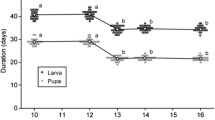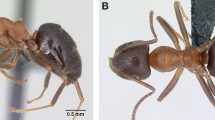Abstract
A novel system for spider mite control was developed with a slow-release sachet containing Neoseiulus californicus (McGregor) (Acari: Phytoseiidae) protected by a waterproof shelter. Monitoring the efficacy of the predator release system for spider mite control at a Japanese pear greenhouse requires discrimination of N. californicus from other indigenous phytoseiid mite species inhabiting the study site and subsequent identification of the released N. californicus. The report of our earlier study described a PCR-based method for discrimination of N. californicus species. For the present study, we first examined phytoseiid mite species composition in the greenhouse. Subsequently, we developed microsatellite markers to identify the released N. californicus. Finally, we installed the predator release system in the greenhouse and conducted a population survey of phytoseiid and spider mites. Results demonstrated that approximately 1 month is necessary for distribution of the released N. californicus on the leaves.



Similar content being viewed by others
References
Bailly X, Migeon A, Navajas M (2004) Analysis of microsatellite variation in the spider mite pest Tetranychus turkestani (Acari: Tetranychidae) reveals population genetic structure and raises questions about related ecological factors. Biol J Linn Soc 82:69–78
Buitenhuis R, Shipp L, Scott-Dupree C (2010) Dispersal of Amblyseius swirskii Athias-Henriot (Acari: Phytoseiidae) on potted greenhouse chrysanthemum. Biol Control 52:110–114
Buitenhuis R, Glemser E, Brommit A (2014) Practical placement improves the performance of slow release sachets of Neoseiulus cucumeris. Biocontrol Sci Technol 24:1153–1166
Croft BA, Jung C (2001) Phytoseiid dispersal at plant to regional levels: a review with emphasis on management of Neoseiulus fallacis in diverse agroecosystems. Exp Appl Acarol 25:763–784
Doker I, Witters J, Pijnakker J, Kazak C, Tixier MS, Kreiter S (2014) Euseius gallicus Kreiter and Tixier (Acari: Phytoseiidae) is present in four more countries in Europe: Belgium, Germany, the Netherlands and Turkey. Acarologia 54:245–248
Gao H, Williamson S, Bustamante CD (2007) A Markov chain Monte Carlo approach for joint inference of population structure and inbreeding rates from multilocus genotype data. Genetics 176:1635–1651
Goudet J (2001) FSTAT: a program to estimate and test gene diversities and fixation indices (version 2.9.3). https://www.unil.ch/izea/softwares/fstat.html
Hancock J (1999) Microsatellites and other simple sequences: genomic context and mutational mechanisms. In: Goldstein DB, Schlötterer C (eds) Microsatellites: evolution and applications. Oxford University Press, Oxford, pp 1–9
Helle W, Sabelis MW (1985) World crop pests. Spider mites: their biology, natural enemies and control, vol 1B. Elsevier, Amsterdam
Hinomoto N, Todokoro Y, Higaki T (2011) Population structure of the predatory mite Neoseiulus womersleyi in a tea field based on an analysis of microsatellite DNA markers. Exp Appl Acarol 53:1–15
Ishii H, Mikawa Y, Murase Y, Sonoda S, Hinomoto N, Kishimoto H, Toyoshima S, Toyama M (2018) Species composition and arthropod pest feeding of phytoseiid mites in Japanese pear greenhouse. Appl Entomol Zool 53:463–474
Jakobsson M, Rosenberg NA (2007) CLUMPP: a cluster matching and permutation program for dealing with label switching and multimodality in analysis of population structure. Bioinformatics 23:1801–1806
Jung C, Croft BA (2001) Ambulatory and aerial dispersal among specialist and generalist predatory mites (Acari: Phytoseiidae). Environ Entomol 30:1112–1118
Kalinowski ST, Taper ML, Marshall TC (2007) Revising how the computer program CERVUS accommodates genotyping error increases success in paternity assignment. Mol Ecol 16:1099–1106
McMurtry JA, Croft BA (1997) Life-styles of phytoseiid mites and their role in biological control. Annu Rev Entomol 42:291–321
Mikawa Y, Ishii H, Nagayoshi A, Sonoda S, Mori K, Toyama N (2019) PCR-based species identification applied in Japanese pear orchards to survey seasonal proportion changes of phytoseiid mite species. Appl Entomol Zool 54:133–139
Navajas MJ, Thistlewood HMA, Lagnel J, Hughes C (1998) Microsatellite sequences are under-represented in two mite genomes. Insect Mol Biol 7:249–256
Nishimura S, Hinomoto N, Takafuji A (2003) Isolation, characterization, inheritance and linkage of microsatellite markers in Tetranychus kanzawai (Acari: Tetranychidae). Exp Appl Acarol 31:93–103
Nishimura S, Hinomoto N, Takafuji A (2005) Gene flow and spatiotemporal genetic variation among sympatric populations of Tetranychus kanzawai (Acari: Tetranychidae) occurring on different host plants, as estimated by microsatellite gene diversity. Exp Appl Acarol 35:59–71
Nomikou M, Janssen A, Schraag R, Sabelis MW (2002) Phytoseiid predators suppress populations of Bemisia tabaci on cucumber plants with alternative food. Exp Appl Acarol 27:57–68
Osakabe M, Hinomoto N, Toda S, Komazaki S, Goka K (2000) Molecular cloning and characterization of a microsatellite locus found in an RAPD marker of a spider mite, Panonychus citri (Acari: Tetranychidae). Exp Appl Acarol 24:385–395
Peakall R, Smouse PE (2006) GENALEX 6: genetic analysis in excel population genetic software for teaching and research. Mol Ecol Notes 6:288–295
Schausberger P, Patiño-Ruiz JD, Osakabe M, Murata Y, Sugimoto N, Uesugi R, Walzer A (2016) Ultimate drivers and proximate correlates of polyandry in predatory mites. PLoS ONE 11:e0154355
Shimoda T, Kagawa Y, Mori K, Hinomoto N, Hiraoka T, Nakajima T (2017) A novel method for protecting slow-release sachets of predatory mites against environmental stresses and increasing predator release to crops. Biocontrol 62:495–503
Uesugi R, Osakabe M (2007) Isolation and characterization of microsatellite loci in the two-spotted spider mite, Tetranychus urticae (Acari: Tetranychidae). Mol Ecol Notes 7:290–292
van Lenteren JC (2001) A greenhouse without pesticides: fact or fantasy? Crop Prot 19:375–384
van Lenteren JC (2011) The state of commercial augmentative biological control: plenty of natural enemies, but a frustrating lack of uptake. Biocontrol 57:1–20
Acknowledgements
This work was financially supported by the Ministry of Agriculture, Forestry and Fisheries, Japan through the Science and Technology Research Promotion Program for the Agriculture, Forestry, Fisheries and Food Industry (28022C). The authors thank ISK Biosciences for providing the predator release system.
Author information
Authors and Affiliations
Corresponding author
Additional information
Publisher's Note
Springer Nature remains neutral with regard to jurisdictional claims in published maps and institutional affiliations.
Electronic supplementary material
Below is the link to the electronic supplementary material.
Rights and permissions
About this article
Cite this article
Mikawa, Y., Aizawa, M., Uesugi, R. et al. Molecular monitoring of Neoseiulus californicus released from sheltered slow-release sachets for spider mite control in a Japanese pear greenhouse. Exp Appl Acarol 80, 203–214 (2020). https://doi.org/10.1007/s10493-019-00463-4
Received:
Accepted:
Published:
Issue Date:
DOI: https://doi.org/10.1007/s10493-019-00463-4




